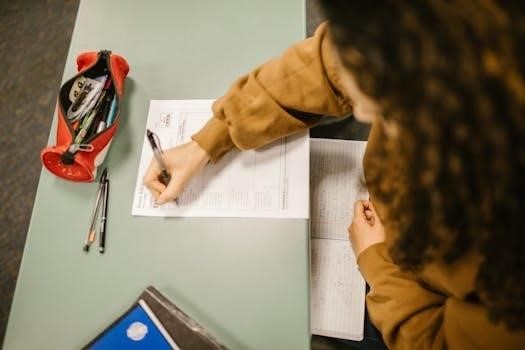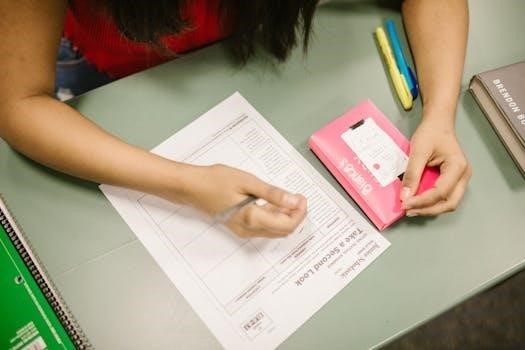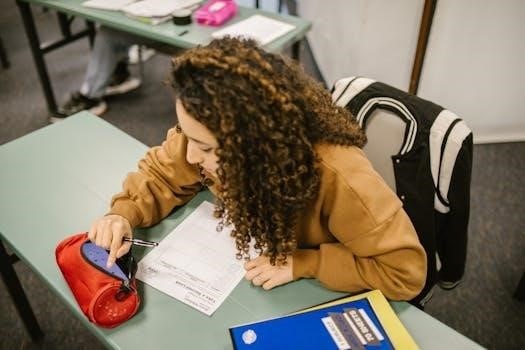
geometry test with answers pdf
Geometry Test Overview
The geometry test assesses understanding of core concepts, often utilizing multiple-choice and fill-in-the-blank formats. Problems range from basic calculations to more complex algebraic solutions involving geometric figures. Practice tests and review materials are essential for preparation. These resources include sample questions and detailed solutions; They help to familiarize students with the types of questions that appear on the test.
Types of Geometry Questions
Geometry tests typically incorporate a variety of question types to assess a broad range of skills and understanding. Multiple-choice questions are common, requiring students to select the correct answer from a set of options. These questions may involve calculations, identification of geometric properties, or application of theorems. Fill-in-the-blank questions present a problem where students must calculate or derive the correct value and enter it into a designated space. This format often tests the ability to recall specific formulas or geometric principles. Additionally, some tests may include questions that involve diagrams, requiring students to analyze shapes, angles, and relationships to find solutions. These questions can assess both spatial reasoning and problem-solving abilities. Often, problems will combine algebraic concepts with geometric figures, testing a student’s ability to integrate these two mathematical areas. It’s also common to find questions related to coordinate geometry, which involve the use of the coordinate plane to solve geometric problems. Ultimately, the diversity in question types ensures a comprehensive evaluation of a student’s geometric understanding.
Multiple-Choice Question Examples
Multiple-choice geometry questions often present a problem scenario followed by several answer options, only one of which is correct. For example, a question might ask for the area of a circle given its circumference, requiring students to use formulas and calculations. Another question could involve identifying the relationship between angles formed by parallel lines cut by a transversal, testing knowledge of geometric theorems. A common multiple-choice question type focuses on triangle properties, asking for the value of an angle or side using theorems like the Pythagorean theorem or the properties of similar triangles. Coordinate geometry questions might ask for the midpoint or slope of a line segment given the coordinates of its endpoints. Some questions may incorporate algebra, requiring students to solve equations to find missing geometric values. When dealing with polygons, multiple-choice items often test recognition of specific properties or the calculation of area and perimeter. It is important to choose the single most accurate answer from the options provided, focusing on precision and understanding of underlying geometric principles.
Fill-in-the-Blank Response Items
Fill-in-the-blank questions in a geometry test require students to provide a numerical answer or a specific term, demonstrating their ability to solve problems accurately without the aid of multiple choices. These items often assess a student’s grasp of fundamental formulas and theorems. For instance, a question could ask for the measure of an angle given certain properties, or the length of a side in a triangle when other lengths are known. Another fill-in-the-blank might focus on calculating the area of a polygon, requiring students to apply the correct formula and compute the answer; Coordinate geometry problems could involve determining the coordinates of a point or finding the slope of a line and filling in the correct values. These questions test not only conceptual understanding but also the ability to perform precise calculations and express the answer in the correct format. Fill-in-the-blank responses leave less room for guessing and require a thorough comprehension of the concepts.

Key Geometry Concepts Tested
Geometry tests often cover circles, triangles, lines, angles, and coordinate geometry. These areas include calculating area and circumference of circles, understanding triangle properties, parallel and perpendicular lines, and using the midpoint and distance formulas.
Circles⁚ Area and Circumference
Understanding circles is crucial for geometry tests, focusing on area and circumference calculations. The circumference of a circle is found using the formula C = 2πr, where r is the radius. Alternatively, it can be calculated with C = πd, where d is the diameter. The area of a circle is given by the formula A = πr2. These formulas are essential for solving various problems. For example, if the circumference is given, you might need to find the radius or diameter first before calculating the area. Problems might also involve finding the area of sectors or relating arc length to the central angle. Remember that π (pi) is approximately 3.14. Be prepared to apply these formulas in different contexts, including word problems and diagrams. Questions might involve working backwards, given the area or circumference to find the radius or diameter, and then using that to find another quantity. Knowing these formulas and being able to manipulate them is very important.
Triangles⁚ Properties and Similarity
Triangles are a fundamental part of geometry, and understanding their properties is vital for success on tests. This includes knowing that the sum of angles in any triangle is 180 degrees. Different types of triangles, such as equilateral, isosceles, and right triangles, have specific characteristics. Similarity of triangles is also a key concept. Similar triangles have the same shape but may differ in size; their corresponding angles are equal, and their corresponding sides are proportional. This is often tested with problems involving proportions to find unknown side lengths. For example, if two triangles are stated to be similar, setting up a proportion between corresponding sides will help to solve for missing information. The Pythagorean theorem (a2 + b2 = c2) applies to right triangles, relating the lengths of the legs to the hypotenuse. Furthermore, medians and other special segments of triangles are often included in problems, requiring an understanding of their properties.
Lines and Angles⁚ Parallel, Perpendicular, Vertical
Understanding lines and angles is crucial in geometry; Parallel lines, which never intersect, have special angle relationships when intersected by a transversal. These relationships include corresponding angles, alternate interior angles, and alternate exterior angles, all of which are congruent. Perpendicular lines, which intersect at a 90-degree angle, form right angles. Vertical angles, formed by the intersection of two lines, are always congruent. Problems often involve using these angle relationships to find unknown angle measures. For instance, if two lines are known to be parallel and one angle is given, one can determine all other angle measures formed by the transversal. Additionally, problems may require applying the concept of supplementary angles (angles that sum to 180 degrees) or complementary angles (angles that sum to 90 degrees). Recognizing these relationships and applying them correctly is a common task in geometry tests.
Coordinate Geometry⁚ Midpoint, Distance, Slope
Coordinate geometry involves using the coordinate plane to study geometric figures. Key concepts include finding the midpoint of a line segment, calculating the distance between two points, and determining the slope of a line. The midpoint formula, which averages the x-coordinates and y-coordinates of two endpoints, helps find the center of a segment. The distance formula, derived from the Pythagorean theorem, calculates the length of a line segment. The slope formula, which is the change in y divided by the change in x, indicates the steepness and direction of a line. Problems often require applying these formulas to solve for missing coordinates, segment lengths, or slopes. Understanding the relationship between slope and parallel or perpendicular lines is also important. Parallel lines have equal slopes, while perpendicular lines have slopes that are negative reciprocals of each other. These concepts are frequently assessed on geometry tests.

Test Preparation Resources
Effective test preparation includes using practice test PDFs, exploring online practice test sites, and reviewing geometry EOC materials; These resources provide sample questions and solutions. This helps students familiarize themselves with the test format and content.
Practice Test PDFs
Practice test PDFs are invaluable tools for geometry test preparation, offering a tangible way to simulate exam conditions. These downloadable documents frequently include a range of question types mirroring those found on actual assessments. Many PDFs provide answer keys, allowing students to check their work and understand the correct solutions. Some resources even offer step-by-step explanations, aiding comprehension of the underlying geometric principles. By working through a variety of practice test PDFs, students can gauge their strengths and weaknesses, enabling them to focus on areas needing improvement. They also help students become comfortable with the format and time constraints of the real test. Furthermore, repeated exposure to different types of questions through practice PDFs can increase confidence and reduce test anxiety. It is advisable to seek out practice tests that align with the specific curriculum and standards of the geometry test being taken. Remember to review the solutions carefully to maximize learning from every practice attempt.
Online Practice Test Sites
Online practice test sites offer an interactive and dynamic approach to geometry test preparation. These platforms often feature a wide range of questions, mimicking the style and difficulty of actual exams. Many sites provide instant feedback, allowing students to quickly identify areas of weakness. Some online resources even offer detailed explanations for each question, enhancing understanding of geometrical concepts. Interactive features, such as timers and progress trackers, add to the learning experience. By using online practice tests, students can familiarize themselves with the format of the assessment and develop effective test-taking strategies. These sites often adapt to the student’s performance, providing personalized practice. Additionally, they give access to a multitude of questions covering a wide spectrum of geometry topics. Regularly engaging with online practice tests can be a great way to build confidence and improve scores. Students should look for reputable sites with high-quality questions and answer explanations. This makes their practice much more effective and efficient.
Geometry EOC Review Materials
Geometry End-of-Course (EOC) review materials are crucial for comprehensive test preparation. These resources often include a thorough overview of key geometrical concepts and theorems. Many review materials offer practice problems specifically designed to match the format and difficulty of the EOC exam. Students can benefit from detailed explanations of solutions, which help to clarify any misunderstandings. Review materials often include a variety of questions, ranging from multiple-choice to fill-in-the-blank, ensuring a well-rounded preparation. Additionally, some materials may include reference sheets or formulas that will be available during the test. Effective review materials help students to identify their strengths and weaknesses, allowing them to focus on specific areas that need improvement. These resources may be available as PDFs, online modules, or printed workbooks. Utilizing a combination of these methods can maximize learning and ensure test readiness. Using EOC review materials allows students to approach the test with confidence, knowing they have covered all the necessary concepts. It helps to build a solid foundation and improve problem-solving skills.

Specific Problem Examples and Solutions
Geometry problems often integrate algebraic techniques for finding solutions. Examples include solving equations for side lengths, angles, or coordinates. Detailed solutions help explain the processes. These examples showcase how algebraic skills are applied in geometric contexts, ensuring thorough understanding.
Algebraic Solutions in Geometry Problems

Geometry problems frequently require the application of algebraic methods to arrive at solutions. These problems go beyond basic geometric principles, often involving equations and variables. For instance, finding unknown side lengths in triangles or determining angle measures can involve setting up and solving algebraic equations. This integration of algebra and geometry is crucial for a comprehensive understanding of mathematical concepts. Students need to be proficient in both areas to tackle these types of problems effectively. The use of algebraic equations often arises when dealing with properties of shapes, such as the relationships between sides in similar triangles or the application of the Pythagorean theorem. Moreover, coordinate geometry problems often require the use of algebraic formulas to calculate distances, midpoints, or slopes. These algebraic techniques provide a powerful tool for analyzing and solving geometric problems, moving beyond simple visual assessments. The ability to translate geometric relationships into algebraic expressions is a key skill tested in geometry assessments. Understanding how these two branches of mathematics interact is essential for success in advanced math courses and real-world applications.
Examples of Equations in Geometry
Geometry often involves the use of various equations to solve problems. These equations can relate to different geometric concepts such as area, perimeter, and angle relationships. For example, the area of a circle is calculated using the formula A = πr², where ‘r’ is the radius. The circumference of a circle is given by C = 2πr. In triangles, the Pythagorean theorem, a² + b² = c², is used to find the lengths of sides in right-angled triangles. The sum of angles in a triangle is always 180 degrees. When working with parallel lines, corresponding angles are equal, which can be written as equations such as ∠a = ∠d. Furthermore, equations are used to describe the relationships between coordinates in the coordinate plane, such as the midpoint formula and the distance formula; The slope of a line is also calculated using an equation m = (y2-y1)/(x2-x1). These equations play a vital role in solving various geometry problems efficiently. Understanding how to apply and manipulate these equations is essential for success in geometry.
Leave a Reply
You must be logged in to post a comment.